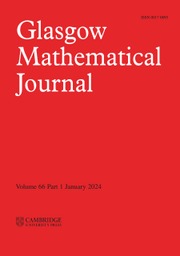No CrossRef data available.
Article contents
On finite groups with bounded conjugacy classes of commutators
Part of:
Representation theory of groups
Structure and classification of infinite or finite groups
Special aspects of infinite or finite groups
Published online by Cambridge University Press: 11 August 2025
Abstract
In 1954, B. H. Neumann discovered that if  $G$ is a group in which all conjugacy classes have finite cardinality at most
$G$ is a group in which all conjugacy classes have finite cardinality at most  $m$, then the derived group
$m$, then the derived group  $G'$ is finite of
$G'$ is finite of  $m$-bounded order. In 2018, G. Dierings and P. Shumyatsky showed that if
$m$-bounded order. In 2018, G. Dierings and P. Shumyatsky showed that if  $|x^G| \le m$ for any commutator
$|x^G| \le m$ for any commutator  $x\in G$, then the second derived group
$x\in G$, then the second derived group  $G''$ is finite and has
$G''$ is finite and has  $m$-bounded order. This paper deals with finite groups in which
$m$-bounded order. This paper deals with finite groups in which  $|x^G|\le m$ whenever
$|x^G|\le m$ whenever  $x\in G$ is a commutator of prime power order. The main result is that
$x\in G$ is a commutator of prime power order. The main result is that  $G''$ has
$G''$ has  $m$-bounded order.
$m$-bounded order.
MSC classification
Information
- Type
- Research Article
- Information
- Copyright
- © The Author(s), 2025. Published by Cambridge University Press on behalf of Glasgow Mathematical Journal Trust
References
Acciarri, C. and Shumyatsky, P., A stronger form of Neumann’s BFC-theorem, Israel J. Math. 242 (2021), 269–278.10.1007/s11856-021-2133-1CrossRefGoogle Scholar
Detomi, E., Morigi, M. and Shumyatsky, P., BFC-theorems for higher commutator subgroups, Quart. J. Math. 70 (2019), 849–858.10.1093/qmath/hay068CrossRefGoogle Scholar
Dierings, G. and Shumyatsky, P., Groups with boundedly finite conjugacy classes of commutators, Quart. J. Math. 69 (2018), 1047–1051.10.1093/qmath/hay014CrossRefGoogle Scholar
Doerk, K. and Hawkes, T., Finite soluble groups (de Gruyter, Berlin, 1992).10.1515/9783110870138CrossRefGoogle Scholar
Eberhard, S. and Shumyatsky, P., Probabilistically nilpotent groups of class two, Math. Ann. 388 (2024), 1879–1902.10.1007/s00208-023-02567-0CrossRefGoogle Scholar
Feit, W. and Thompson, J. G., Solvability of groups of odd order, Pacific J. Math. 13 (1963), 773–1029.Google Scholar
Guralnick, R. M. and Maroti, A., Average dimension of fixed point spaces with applications, J. Algebra 226 (2011), 298–308.Google Scholar
Khukhro, E. I., Nilpotent groups and their automorphisms (De Gruyter, New York, 1993).10.1515/9783110846218CrossRefGoogle Scholar
Neumann, B. H., Groups covered by permutable subsets, J. London Math. Soc. 29 (1954), 236–248.10.1112/jlms/s1-29.2.236CrossRefGoogle Scholar
Neumann, P. M. and Vaughan-Lee, M. R., An essay on BFC groups, Proc. Lond. Math. Soc. 35 (1977), 213–237.10.1112/plms/s3-35.2.213CrossRefGoogle Scholar
Robinson, D. J. S., A course in the theory of groups,
Graduate Texts in Mathematics
, vol. 80, 2nd edition (Springer-Verlag, New York, 1996).10.1007/978-1-4419-8594-1CrossRefGoogle Scholar
Segal, D. and Shalev, A., On groups with bounded conjugacy classes, Quart. J. Math. 50 (1999), 505–516.10.1093/qjmath/50.200.505CrossRefGoogle Scholar
Shumyatsky, P., Bounded conjugacy classes, commutators and approximate subgroups, Quart. J. Math. 73 (2022), 679–684.10.1093/qmath/haab049CrossRefGoogle Scholar
Wiegold, J., Groups with boundedly finite classes of conjugate elements, Proc. Roy. Soc. London Ser. A 238 (1957), 389–401.Google Scholar


